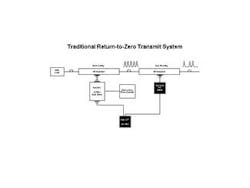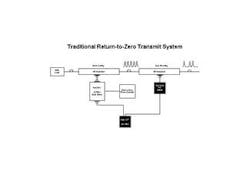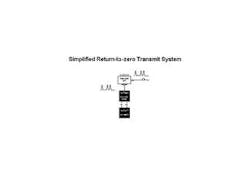Lowering the cost and size of RZ
By MATTHEW DRU and ANGUS LAI, Vitesse Semiconductor, DAVID HUFF and JIAMING ZHANG, T-Networks--Return-to-zero (RZ) transmission systems can increase the signal distance and link performance in optical networks. The return-to-zero, or blanking interval, between data pulses in RZ systems reduces the effects of inter-symbol interference in dispersive transmission media. However, RZ transmission is rarely considered outside of ultra-long-haul applications because of the cost and complexity of the transmitter design. Traditional approaches to RZ transmitter designs require several components--a constant wavelength (CW) laser, two lithium niobate (LiNbO3) modulators, and two high-voltage drivers that consume significant electrical power.
A new, more efficient, approach uses a monolithic RZ driver and an electro-absorption modulator (EAM) based device, which require substantially lower drive voltages. Recent developments in the driver and the EAM technologies enable a viable solution for large metro and regional DWDM systems at substantially reduced cost.
Traditional designs
Three optical components comprise the classic RZ system: a CW laser as a light source, a LiNbO3 Mach-Zender (MZ) modulator for RZ pulse carving, and another MZ modulator for data encoding. Each modulator requires an accompanying voltage driver. The data-encoding non-return to zero (NRZ) driver must output at least 6V of peak-to-peak swing and, in the case of the clock driver, more than 10V of peak-to-peak swing. Additional support circuitry is required to maintain phase relationship between the pulse carving modulator and the data encoding modulator. See Figure 1 for a block diagram of this system.
Deployed in multiple ultra-long-haul systems, the classic RZ transmitter system is a proven architecture, but for consideration in other applications it must evolve to a smaller, lower cost configuration. This evolution is facilitated by next-generation technology originally developed for 40-Gbit/sec applications. (In this case, 40-Gbit/sec technology is offering a cost reduction for a 10-Gbit/sec solution.)
New architecture
With the benefits of advanced indium phosphide (InP) heterojunction bipolar transistor (HBT) technology, the two drivers can be integrated into a monolithic RZ driver. Utilizing EAM with sufficient bandwidth to generate RZ pulses directly reduces the number of optical components from five to two. A 70% cost advantage is realized as the fundamental components in the RZ transmitter system are reduced, in addition to a 5x smaller footprint for the implemented transmitter.
The InP technology offers a HBT with 150-GHz cutoff frequency (Ft) and 150-GHz maximum oscilation frequency (FMAX) enabling the 20-GHz circuit bandwidth necessary to generate RZ pulses directly from the driver. The driver has both a NRZ data input and a clock input, where the RZ pulses are generated based on the clock input so that the pulse width scales with clock frequency. The re-timer and RZ pulse formatter are based on static logic designs so that the driver can operate from DC to 10.7 Gbits/sec. Advances in next-generation EAM technology offer bandwidths greater than 15 GHz enabling direct generation of RZ optical pulses from RZ formatted electrical pulses.
Adding the CW laser in the same package as the EAM reduces the optical component count from two to one by creating an electro-absorption modulated laser (EML). Figure 2 shows the simplified RZ transmitter system, which consists of an EML combined with the RZ driver. The RZ formatter in the driver offers pulse-width control along with the DC bias offset control of the EAM; a 20-psec pulse-width tuning range is achieved. This combined with the ability to tune the extinction ratio, output power, and chirp, offers the system engineer all of the necessary hooks to optimize the transmission system. Such systems have already demonstrated over 3000-km transmission in laboratory settings.
Mechanically, the classic RZ system is limited to a line card implementation. The physical size of the CW laser, modulators, and fiber routing takes up more area than any commercially available optical transponder. In comparison, the EML-based system offers the same footprint as the CW laser alone. The driver form factors are also an important consideration. The data driver is available in a ball-grid array, which is a reasonable form factor. However, the clock driver is only available in a gold box with coaxial connectors. Combined, the two drivers can only be assembled onto a line card. In comparison the RZ driver is available in a smaller footprint than the NRZ driver. Looking ahead at the total power combined, the data driver, clock driver, and phase controller represent 10W, which places further constraints on the minimum size due to heat sinking requirements.
Compatible with 300-pin MSA transponders
Moving to an EML-based transmitter reduces the footprint, and the power requirements. The simplified RZ transmitter system requires 3W total, and fits in existing 300-pin MSA transponder designs. This configuration offers substantial value in metro and regional applications, where most system manufacturers are converting their platforms to 300-pin MSA designs by providing the ability to easily upgrade the optics of these systems to address the emerging longer reach metro and regional long haul requirements. The monolithic driver design also allows for dynamic switching between RZ and NRZ data formats. This capability enables the system designer to stock fewer part numbers because it provides interoperability with other NRZ-based transponder modules and supports further distances on defined RZ links.
The cost and power savings this simplified configuration offers is bringing new life to the RZ data format. In dispersion-managed metro and regional long-haul markets, the RZ format is not usually considered as a solution. The complexity of the classic RZ system is too high to meet the price points and configurations of most system builders. By reducing the design to two-components, the system builder can now consider the RZ format on the same plane in terms of cost and complexity, as any other EML-based design.
Matthew Dru is senior product marketing engineer, and Angus Lai is an applications engineer at Vitesse Semiconductor Corp. (Camarillo, CA). David Huff is vice president of marketing and Jiaming Zhang is senior applications engineer at T-Networks, Inc. (Allentown, PA).

